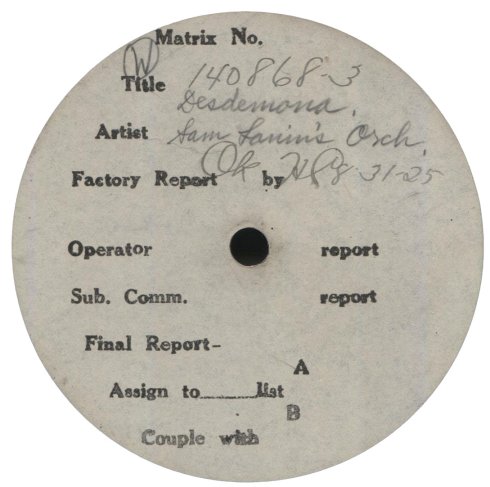
“Desdemona”
Sam Lanin’s Orchestra
(Test Pressing Matrix 140868-3, issued on Columbia 447-D) August 27, 1925
Here is a single-sided test pressing I found while sorting through the Edward Mitchell collection.
Test pressings were just that, a one-off pressing of a recording, usually ahead of it being issued, so that various record label staff members could listen to and/or evaluate it. Test pressings are always worth looking into because sometimes they contain alternative, non-issued takes of an issued recording or, in some cases, of a recording that, for whatever reason, was never issued.
In this instance, it is of a very nice recording of “Desdemona” by Sam Lanin and His Orchestra recorded on August 27, 1925 One can tell from the arrangement that it was made during the height of the “Charleston” dance craze. The recording was assigned a matrix number of 140868. On the label, it is listed as 140868-3, indicating it was the third take.
In those days, there was no such thing as “mixing” a recording. The entire musical ensemble gathered before the microphone or, before the advent of electrical recording, the recording horn and played it “live.” If one of the musicians messed up or there were technical issues, everyone had to start over again with another blank wax disc and perform however many takes were necessary to capture an acceptable recording.
Multiple discographies indicate that three takes were made of “Desdemona,” with the third take being the one that was ultimately issued on Columbia 447-D, which was coupled with the Lanin Orchestra’s recording of “The Promenade Walk” on the flip side. Since this test pressing is of that third take, its musical contents are identical to that of the issued record.
Despite not being one of the two unissued takes, the record is still interesting for the label that was attached to it. Many test pressings only have a blank label and, if one is lucky, it might have handwritten notations regarding song title, artist credit and perhaps a matrix number if it was not already stamped into the pressing. But, here, the label contains a pre-printed blank template that offers some insight into Columbia’s quality assurance and approval process.
Observe in the above image that there are spaces for approval and/or comments by various departments or individuals: the factory, the operator (whatever that might have indicated), a sub-committee, as well as the final outcome of that process.
If my interpretation is correct, it appears that the recording was given the OK by someone associated with the factory whose initials were H.O on August 31, 1925, four days after it was recorded. I have no way of knowing if, from there, that same test pressing was to be passed on to the other departments or if the relevant people in each department were provided with and signed off on their own separate test pressings. My guess is the latter, given that the recording was subsequently issued and there are no further notes on the label.
At the bottom is a place to note the matrix number of the recording they ultimately decided to couple with it on the flip side.
What I find interesting is that there appear to be options for indicating whether the recording will be on the record’s A-side or B-side. But during this period and previously, Columbia was one of the labels that did not show an A-side or B-side. The same catalog number appeared on both sides underneath the artists’ credits with each side’s unique matrix number listed in smaller font underneath the catalog number. My only guess as to why it might have been necessary for them to designate an A-side and B-side is that it was perhaps, for some reason, necessary to do so when setting up the stampers in the machinery that pressed the records.
Also of note is the circled letter W in the upper left-hand portion of the label. That same circled letter W can also be found stamped into the record’s run-out area, indicating that it was recorded electrically rather than acoustically. The W stood for Western Electric, which licensed the technology to both Columbia and rival Victor (Victor recordings made with the Western Electric system have an oval containing the letters VE stamped into the run-out area).
Columbia started making electrical recordings in April 1925. However, it was a few months before they fully phased out recording sessions using their old acoustical equipment for new releases on their flagship Columbia label. During this period, both Columbia and Victor kept quiet about using the new technology and held off announcing it to the public until the latter part of the year. This gave them time to build up a new catalog of electrically recorded releases and to sell off their inventory of existing records that would soon be regarded as obsolete.
Because Columbia had been conducting recording sessions with both the old and new technologies, it makes sense that, as a recording went through its internal review process, various people might want to see at a glance which technology was used without having to play the record.
“Desdemona” was composed by Maceo Pinkard, a black music publisher and composer whose most famous composition was “Sweet Georgia Brown,” which remains well-known as the theme song of the Harlem Globetrotters basketball team.
One will occasionally come across test pressings of pre-World War II recordings made using the original masters or stampers in vinyl, which did not come into use until after the war. Sometimes, such pressings were made in preparation for reissuing a recording in a more modern format. I suspect that, in some cases, they might have been made by record label employees who had the ability to do so for their own personal enjoyment. Such test pressings are treasured for the significantly quieter surface that vinyl provides versus the shellac-based surface of the original pressings.
– Dismuke
